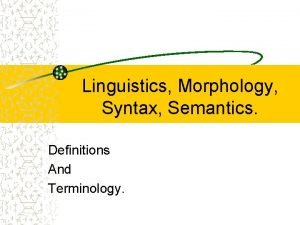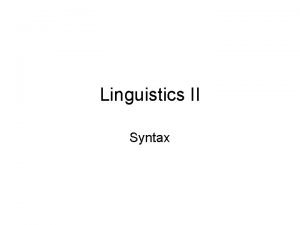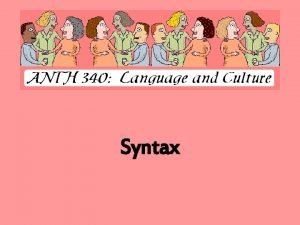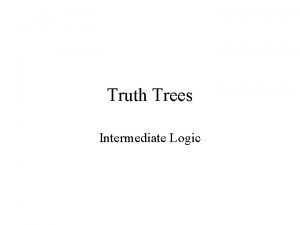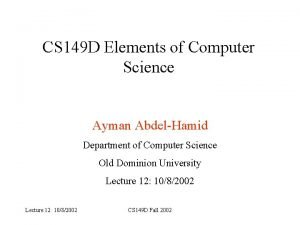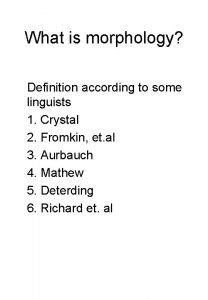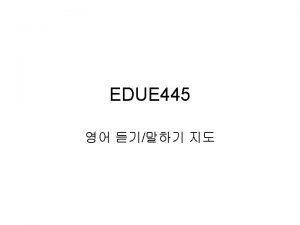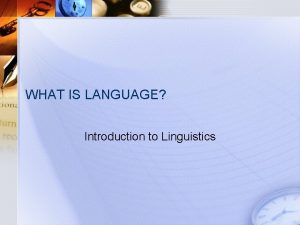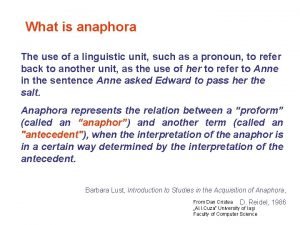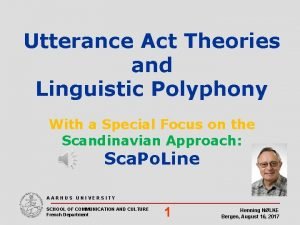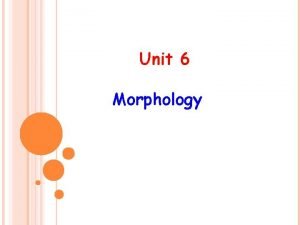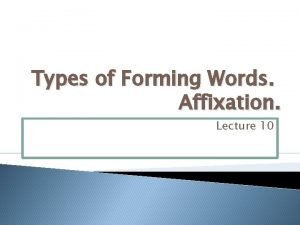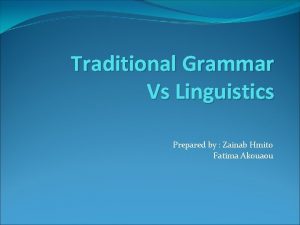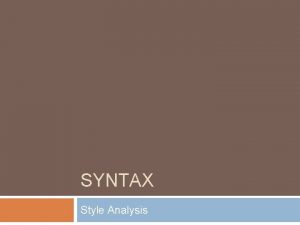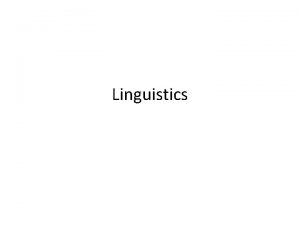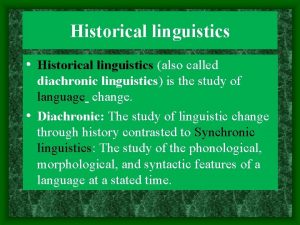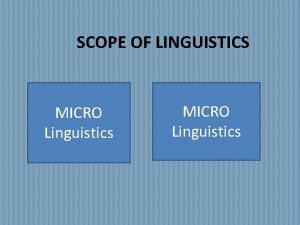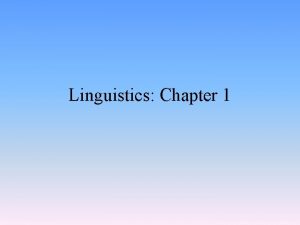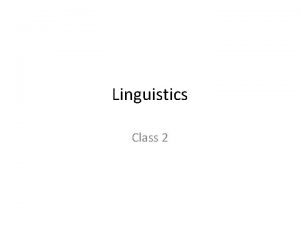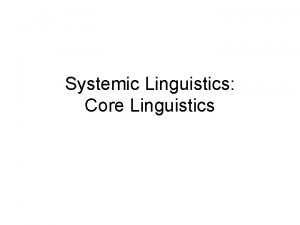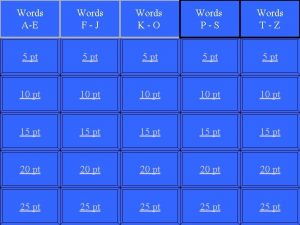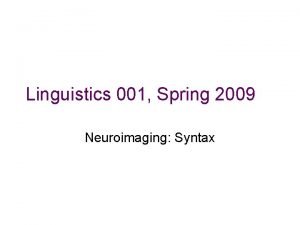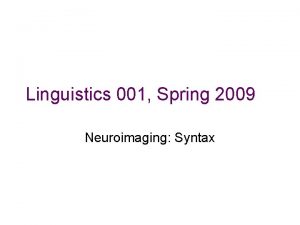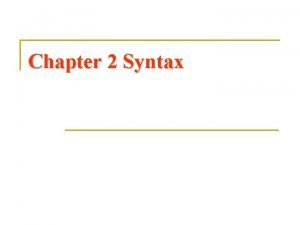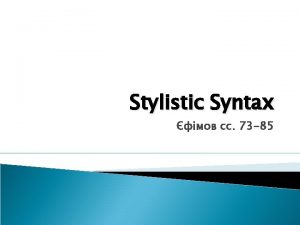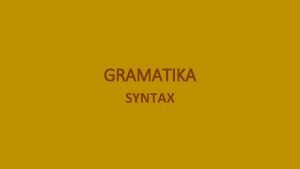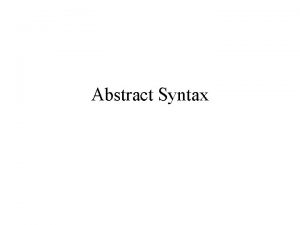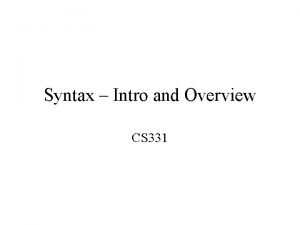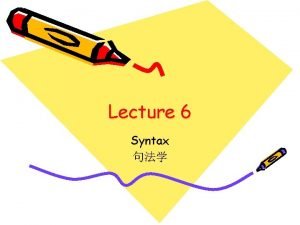Linguistics II Syntax Syntax Rules of how words














![Simple grammar with features • S → NP[num=X] VP[num=X] • NP[num=X] → det[num=X] n[num=X] Simple grammar with features • S → NP[num=X] VP[num=X] • NP[num=X] → det[num=X] n[num=X]](https://slidetodoc.com/presentation_image_h/e473687534c6e54026e957afc6b40946/image-15.jpg)





- Slides: 20

Linguistics II Syntax

Syntax • Rules of how words go together to form sentences • What types of words go together • How the presence of some words predetermines others • What sequences are legitimate?

Word classes • Classic “parts of speech” – closed class (grammatical words): • Prepositions, articles, pronouns, … – open class (lexical words): • nouns, verbs, adjectives, adverbs • How to define word classes – Form – Function – Meaning

How to define word classes • Form (what they look like) – Distinctive “appearance” – morphological behaviour (what inflections can they take? ) • Function (what they do) – What other words do they co-occur with? • Meaning (what they mean) – E. g. word which names something, doing word, word which describes a quality

How to define word classes • Structuralism: substitution classes The very old man walked slowly down the street The very young man walked slowly down the street The rather young man walked slowly down the street That rather young woman ran quickly down the street That rather young woman ran quickly up the street

How to define word classes • Structuralism: constituents The very old The He He He The very old man walked slowly down the street walked slowly there will walk slowly there man walked slowly down the street

How to define word classes • Structuralism: constituents NP Verb group Adj. P The very old The He He He Adv. P man walked slowly down the street walked slowly there will walk slowly there

Grammar • Tries to capture the range of possible sentences in “rules” • Most common type is a “context-free grammar” using a “rewrite rule formalism” • (We’ll explain “context-free” later)

Simple grammar • • S → NP VP adv NP → det n NP → det Adj. G n NP → det n PP NP → det Adj. G n PP PP → prep NP • • VP → v NP PP VP → v NP VP → v PP Adj. G → adj Adj. G → adv adj Lexicon det → {the, this, these, a, an} n → {man, girl, men, girls, apple, street, bowl} prep → {with, to, from, in} v → {eat, eats, ate, speaks, spoke, comes, came} adj → {big, old, pretty, delicious} adv → {very, rather, quickly}

Simple grammar • Notice that rules always have only one symbol on the left-hand side, any number of symbols on the right • Terminal and non-terminal symbols • Rule could be simplified with some additional notation, e. g. brackets to show optionality – NP → det (Adj. G) n (PP)

Tree structures S NP det VP n v PP prep the boy spoke to NP det n the girl

Tree structures S VP PP NP NP det n v the boy spoke prep det to the n girl

Simple grammar • Notice that the rules (despite the direction of the arrow) can be used to produce strings (starting from a left-hand side) or to verify that a given string is grammatical (and to say what its structure is) • What sentences does the grammar account for? • The grammar generates some strings which we judge to be ungrammatical. Why?

Subcategorization • One way to solve overgeneration would be to have more specific categories, e. g. – VP → vitr – VP → vtr NP • Not so attractive, because it would lead to duplication of many rules, and loss of generalization • As a compromise, rules can have additional conditions in the form of features
![Simple grammar with features S NPnumX VPnumX NPnumX detnumX nnumX Simple grammar with features • S → NP[num=X] VP[num=X] • NP[num=X] → det[num=X] n[num=X]](https://slidetodoc.com/presentation_image_h/e473687534c6e54026e957afc6b40946/image-15.jpg)
Simple grammar with features • S → NP[num=X] VP[num=X] • NP[num=X] → det[num=X] n[num=X] • NP[num=X] → det[num=X] Adj. G n[num=X] • VP[num=X] → v[num=X, type=itr] • VP[num=X] → v[num=X, type=tr] NP • etc Lexicon det[num=sing] → {the, this, a, an} det[num=plur] → {the, these} n[num=sing] → {man, girl, apple, street, bowl} n[num=plur] → {men, girls} v[num=sing, type=itr]→ {eats, ate, speaks, spoke, comes, came} v[num=plur, type=itr] → {eat, ate, speak, spoke, come, came} v[num=sing, type=tr] → {eats, ate} v[num=plur, type=tr] → {eat, ate}

Grammatical functions • Context-free grammar defines constituency and structure … • … but says nothing about function • Sentence-level functions are things like subject, object • Within noun-phrases: determiners, modifiers • In each constituent, one element may be identified as the head

Complements and adjuncts Consider: The man smashed the vase with a hammer yesterday by accident. • ‘Complements’ are arguments closely connected to the verb, without which the sentence is ungrammatical • ‘Adjuncts’ add meaning to the proposition as a whole, and are generally optional

Complements • Predictable from (or definitive of) the verb’s ‘subcategorization frame’ • May be compulsory or optional • Verb specifies its complements in form, function and content – Form: NP, PP, that-S, infinitive, … – Function: subject, object, prep-obj, … – Content: syntactic or semantic features

Word order • Grammar defines word-order • Globally, languages can be classified according to basic word-order: – – SVO (verb-medial, eg English) SOV (verb-final, eg Hindi, Japanese, German) VSO (verb-initial, eg Arabic, Welsh) these are the most common • SVO also means typical NP is det n mod, “verbfinal” actually means “head-final”, etc.

Word order • Some languages have “free word-order” though few are completely free, and choice of wordorder usually carries pragmatic significance; Finnish said to be completely free word-order • Many allow “scrambling”, eg Japanese, German have free word-order as long as verb is final • Word-order often indicates grammatical function (eg English), so free word-order languages must compensate, usually with lots of inflectional morphology
 Traditional linguistics and modern linguistics
Traditional linguistics and modern linguistics Applied linguistics
Applied linguistics What is syntax and semantics
What is syntax and semantics Syntax directed translation scheme
Syntax directed translation scheme Syntax rules
Syntax rules Html 5 syntax
Html 5 syntax Syntax literary definition
Syntax literary definition Truth tree
Truth tree Unlike traditional production rules, association rules
Unlike traditional production rules, association rules Ei ie words
Ei ie words A set of rules, symbols, and special words
A set of rules, symbols, and special words Inflectional morpheme
Inflectional morpheme Linguistics as a science
Linguistics as a science Dialectology in linguistics
Dialectology in linguistics Langua
Langua Competence vs performance in linguistics
Competence vs performance in linguistics Anaphora and antecedent
Anaphora and antecedent Utterance definition linguistics
Utterance definition linguistics A morpheme has two elements
A morpheme has two elements Wat is een afleiding
Wat is een afleiding Strengths and weaknesses of traditional grammar
Strengths and weaknesses of traditional grammar


